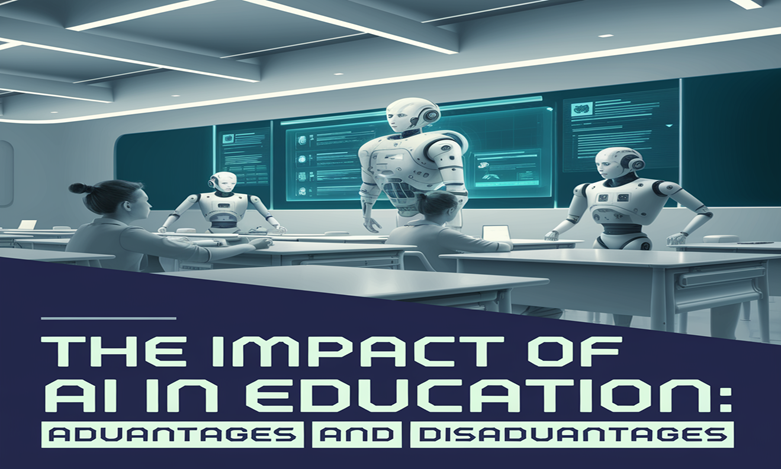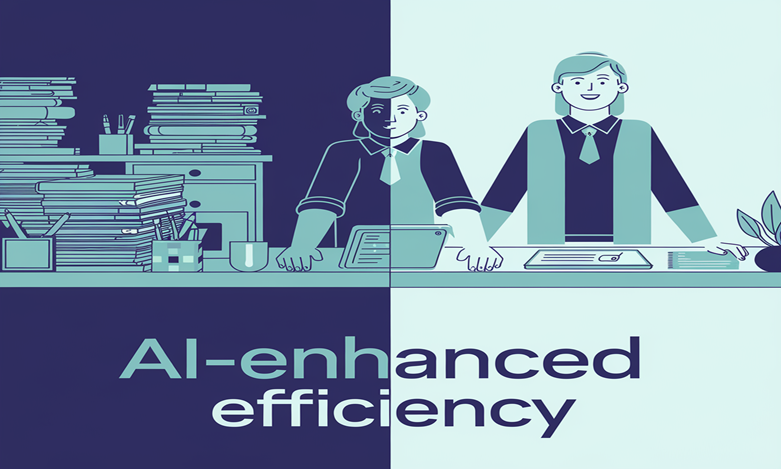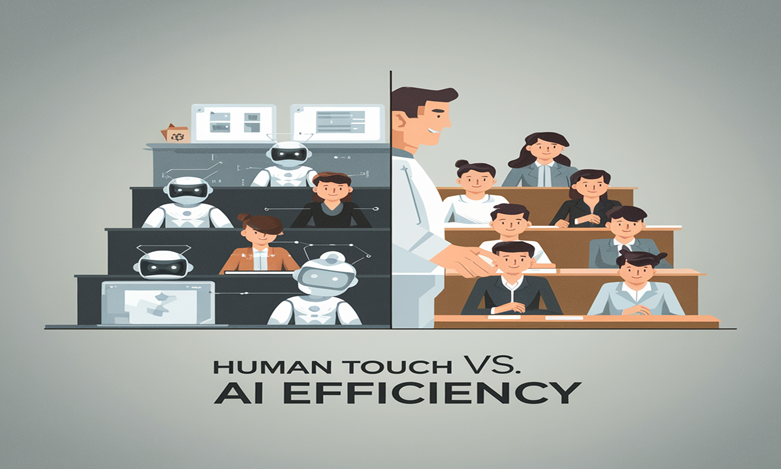The Pros and Cons of AI in Education: Advantages and Disadvantages Explained

Introduction
Artificial Intelligence (AI) is transforming numerous sectors, and the field of education is no different. In recent years, the adoption of AI in education has accelerated, with schools, universities, and elearning platforms integrating AI tools to enhance learning experiences. From personalized learning paths to automated grading systems, AI is reshaping how education is delivered and accessed.
However, as transformative as AI is, it comes with its challenges. This article delves into the pros and cons of AI in education, exploring its advantages and disadvantages for students, educators, and institutions alike. By understanding these aspects, stakeholders can harness the power of AI responsibly and effectively.
What is the significance of AI in the field of education?
What is Artificial Intelligence (AI)?
Artificial intelligence (AI) refers to developing computer systems that can perform tasks typically requiring human intelligence, such as reasoning, learning, and problem-solving.
In the education sector, using AI offers numerous opportunities to transform education. For instance, AI can help personalize learning experiences for students and educators, enabling tailored educational content that meets individual needs.
By leveraging AI, educators can enhance student engagement and foster a more interactive learning environment. However, artificial intelligence has pros and cons in education. Advantages of AI are when we talk about accessibility and efficiency.
On the other hand, disadvantages of AI, that are concerned a lot, are data privacy and replacing your traditional teaching methods. AI will drive the future of education and present challenges that must be dealt with, but the trade-offs must be considered.

How AI is Used in Education
AI in education comes in many shapes. Virtual Tutors offer on-demand help to learners, while adaptive learning platforms modify the delivery of content based on the individual’s learning pace.
The automated grading system saves educators a lot of time, allowing them to spend more time on instruction than administration. In addition, personalized learning tools can better address individual students’ needs. These advances demonstrate the power of AI to make education more effective and personal.
The Benefits of Artificial Intelligence in Education

Tailored Educational Experiences
Among the most advantageous elements of AI in education is its potential for personalizing learning experiences. Classrooms need help to meet the needs of different kids. For example, a student struggling with a math concept might be given additional practice problems of a particular type. In contrast, a student who has mastered the idea could move on to more advanced material. This customization ensures that students learn individually, improving comprehension and retention.
Enhanced Operational Effectiveness
AI streamlines administrative tasks like grading, scheduling, and record management. Automated grading systems can, for example, grade multiple-choice tests and even some essay prompts. This minimizes the teacher’s burden and allows them to concentrate on more interactive and creative teaching.
AI automates routine tasks, saving time and minimizing human error, which helps improve accuracy in recordkeeping and assessment.

Increased Accessibility to Learning
AI is democratizing education, giving students with disabilities or those living in rural blankets access to previously unavailable knowledge. Speech-to-text software helps hear students, while AI-based language translation apps help non-native speakers of a language comprehend course content better.
AI-based learning platforms have also closed the loopholes for students who cannot reach the school, making quality education available at your convenience anytime and anywhere.
Skill Development for the Future
Enhancement of Learning and Keeping Students Future-Ready AI not just enhances learning. When students are exposed to AI technology through education, they will have an entirely new skill set, including problem-solving, critical thinking, analytical skills, and understanding of AI systems. This is important in an age where every industry prizes technological literacy.
The Disadvantages of AI in Education
Lack of Human Interaction
AI technologies work exceptionally well in delivering content, automating routine tasks, and even grading assessments, but they cannot replace the emotional and social interaction of the human teacher.
Too much dependence on AI in the classroom may erode the teacher-student relationship, which is essential for creating motivation, empathy, and communication skills. Students’ emotional and social development requires human interaction, something that no amount of innovation can teach an AI system, no matter how sophisticated it may become.

Bias and Inequality in AI Systems
AI systems are only as free of bias as the data used to train them. However, algorithmic biases can be unintentionally detrimental to some groups of students, perpetuating inequalities instead of combating them. AI-driven assessments, for instance, may privilege students from backgrounds aligned with the training data. Those whose learning styles or cultural context may differ are more likely to be overlooked.
Privacy and Security Concerns
Educational tools using AI frequently harvest vast quantities of information about students, from their performance and behaviour to personal details. This raises serious concerns about data privacy and security implications.
If someone gains access to this information or uses it without permission, the consequences could be dire for students and organizations. To avoid such risks, take solid measures for data protection and comply with privacy laws and necessary rules.

Expense of Execution
Implementing AI technologies comes with a high price, and the cost is a crucial barrier to entry for many underfunded schools and institutions. Acquiring AI-influenced tools and resources and training teachers on how to use them requires a financial commitment, which is potentially hefty.
AI in education can be very expensive, and you have to deal with the hindering factors of infrastructure, among others, to make it efficient with proper funding.
Case Studies and RealWorld Examples
AIPowered Learning Tools in Action
AI-powered platforms like DreamBox and Julian™ are great examples of technology-enabling learning. DreamBox is an adaptive and personalized tool used to help teach mathematics, and Julian™ is an AI tutor that learns and offers students support across subjects. Such tools illustrate how AI can enhance the learning experience by catering to personal strengths and weaknesses.
Schools Adopting AI
AI is helping generate EdTech applications and installations for better administration and teaching. Coordinate the innovative campus with their learning by AI. For instance, one of these applications is issuing AIdriven chatbots by several universities to address student queries or the predictive analytics employed by some universities to identify at-risk students for timely intervention. These are real-world applications of how AI can transform education.
Ethical and Practical Considerations

Ethical Challenges of AI in Education
AI can make quite a difference in education, but that comes with serious ethical concerns. Should AI, for example, be used in high-stakes decisions such as admissions or grading? Most, if not all, AI algorithms are not transparent, and because of this, you may have issues with fairness and accountability. To address these challenges, educators and policymakers must work together to ensure that AI is used ethically and fairly in the education system.
Strategies to Address Challenges
Schools and institutions can adopt a few strategies to mitigate the risks associated with AI: transparency of AI systems, training educators on AI usage, and engaging those who will be most impacted in decision-making processes.
Addressing these concerns will provide institutions with a foundation for a balanced approach to integrating AI.
The Prospects of Artificial Intelligence in Education

Emerging Trends in AI for Education
AI in future education includes some promising trends, such as Generative AI, which is used to develop personalized learning resources, and VR/AR-based AI tools, which provide immersive learning experiences. These innovations have the potential to make education more engaging and effective.
Preparing for an AIDriven Educational Landscape
As AI evolves, institutions must spend money on technology infrastructure, training, education mindset, and much more. It must be noted, however, that adopting these changes will not only accelerate the necessity of future generations to adapt to the rapidly changing landscape of learning.
Conclusion
Hence, AI in education can completely change how we learn, help students improve efficiency, and work towards preparing them for the future. Benefits (including personalized learning and enhanced accessibility) point to its value. However, these disadvantages, such as privacy concerns and less human interaction, highlight the need for caution.
When implemented ethically and responsibly in education, AIs can have positive effects while mitigating negative consequences. In the long run, a multi-pronged approach will contribute to a future in which AI enhances, instead of supplanting, conventional learning.
FAQs
In what ways is artificial intelligence applied in the field of education?
It is also highly personalized for learning as per each individual, with AI technology used for grading, tutoring, and handling administrative tasks, making the overall process much quicker and more streamlined.
What are the benefits of artificial intelligence in the field of education?
AI gives personalized learning, administrative efficiency, improved accessibility, and future-ready skill development.
What are the drawbacks of artificial intelligence in the education sector?
Disadvantages involve less interaction with human beings, the possibility of algorithmic bias, privacy concerns, and the cost of high implementations.
How does the future of artificial intelligence in the field of education appear?
Emerging technologies such as generative AI and VR-based learning will transform the ed-tech industry by making education cutting-edge, engaging, and personalized in the future.

Hello Readers! I’m Mr. Sum, a tech-focused content writer, who actively tracks trending topics to bring readers the latest insights. From innovative gadgets to breakthrough technology, my articles aim to keep audiences informed and excited about what’s new in tech.